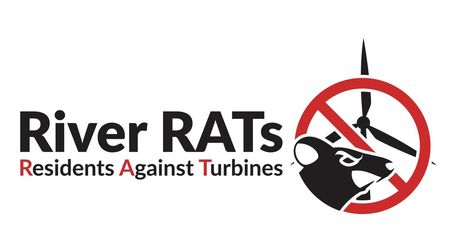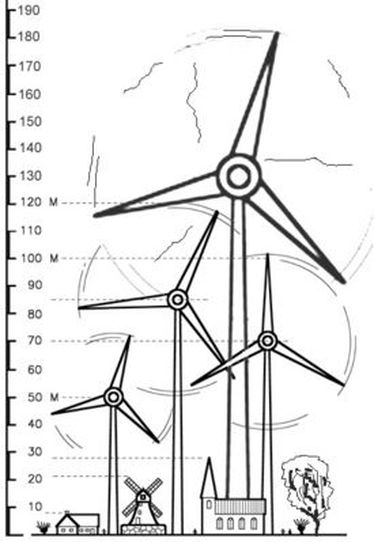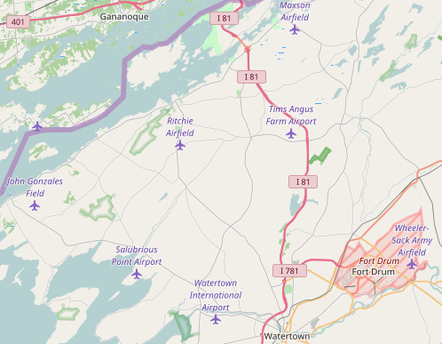Horse Creek Would Site Turbines Too Close to WIA
Horse Creek's wind turbines, located less than five miles from the Watertown International Airport (WIA), pose a significant threat to current flight operations and also plans for future growth. WIA provides private, commercial and military services (Fort Drum accounts for 30% of operations). WIA is an Essential Air Services community airport that supports business and tourist related passenger flights to the area.
As has been demonstrated in reports commissioned by the Department of Homeland Security (DHS), wind turbines interfere with radar operations. Additionally, wind turbines present "vertical obstructions" to flight paths that could jeopardize WIA future growth and impact the overall growth of Jefferson County. These concerns occur at a time when WIA is on an upswing in activity and improvements, including more than $3.5 million in federal funding that was used for the recently completed runway extension project.
Speaking about the FAA funding authorization in September 2016, U.S. Sens. Charles E. Schumer and Kirsten E. Gillibrand expressed the importance of Watertown International Airport to the regional economy,
“We worked very hard to secure this funding because better service in to and out of Watertown is fundamental to growing the region’s economy and to attracting more planes and more business and more tourism to the region,” Sen. Schumer said. “With this funding, the Watertown International Airport will be able to make the critical upgrades necessary to ensure its runway and taxiway are top-notch and safe for the passengers and pilots who fly in and out of Watertown every day.”
“Watertown International Airport is a vital economic anchor in Jefferson County, and it has to meet the best standards for efficiency and safety," Sen. Gillibrand said. "Investing in our airport’s infrastructure will make it better for the businesses and travelers who rely on it every day.”
In 2016, the airport also received state recognition for its recently completed projects. The new fixed business operator and hanger were awarded the Phil Brio Project of Year Award by the New York Aviation Management Association.
As has been demonstrated in reports commissioned by the Department of Homeland Security (DHS), wind turbines interfere with radar operations. Additionally, wind turbines present "vertical obstructions" to flight paths that could jeopardize WIA future growth and impact the overall growth of Jefferson County. These concerns occur at a time when WIA is on an upswing in activity and improvements, including more than $3.5 million in federal funding that was used for the recently completed runway extension project.
Speaking about the FAA funding authorization in September 2016, U.S. Sens. Charles E. Schumer and Kirsten E. Gillibrand expressed the importance of Watertown International Airport to the regional economy,
“We worked very hard to secure this funding because better service in to and out of Watertown is fundamental to growing the region’s economy and to attracting more planes and more business and more tourism to the region,” Sen. Schumer said. “With this funding, the Watertown International Airport will be able to make the critical upgrades necessary to ensure its runway and taxiway are top-notch and safe for the passengers and pilots who fly in and out of Watertown every day.”
“Watertown International Airport is a vital economic anchor in Jefferson County, and it has to meet the best standards for efficiency and safety," Sen. Gillibrand said. "Investing in our airport’s infrastructure will make it better for the businesses and travelers who rely on it every day.”
In 2016, the airport also received state recognition for its recently completed projects. The new fixed business operator and hanger were awarded the Phil Brio Project of Year Award by the New York Aviation Management Association.
Again we ask - Why put all this in jeopardy for the poorly sited Horse Creek project?
Horse Creek Would Site Turbines Too Close to Fort Drum
Fort Drum is a major U.S. Army base located only eight miles southeast from the Horse Creek project area. With over 18,000 full-time military and civilian jobs, Fort Drum is also a Designated Regional Collective Training Center that provides full-spectrum training and base operations support to all the service branches and trains an additional 23,000 Reserve, National Guard and other agency personnel annually. Overall, Fort Drum is a $1.2 billion annual economic driver to the region. Fort Drum is the headquarters of the famed 10th Mountain Division, which has been deployed over 20 times to Iraq and Afghanistan since 2001. Aviation and drone training from the base regularly occurs in and around Clayton.
Fort Drum is also Jefferson County's largest single employer, employing about 18% of the county, approximately 18,000 military personnel and civilians.
If Horse Creek is built, the project's turbines could potentially interfere with the base's radar systems. Such interference could result in a loss of functionality and a weakened bidding position for future projects and expansion.
Turbine interference from projects like Horse Creek is a serious military concern. As Fort Drum's Post Commander, Maj. General Jeffrey Bannister recently stated in an interview with the Watertown Daily Times about the ongoing Joint Land Use Study and the effects of wind turbine projects near the base,
Fort Drum is also Jefferson County's largest single employer, employing about 18% of the county, approximately 18,000 military personnel and civilians.
If Horse Creek is built, the project's turbines could potentially interfere with the base's radar systems. Such interference could result in a loss of functionality and a weakened bidding position for future projects and expansion.
Turbine interference from projects like Horse Creek is a serious military concern. As Fort Drum's Post Commander, Maj. General Jeffrey Bannister recently stated in an interview with the Watertown Daily Times about the ongoing Joint Land Use Study and the effects of wind turbine projects near the base,
“That’s what I’m more interested in — using our systems here like we use them in combat. Why tie our hands at home?”
“We don’t have our hands tied in combat.”
Exacerbating the problem for Fort Drum is that the base is currently one of three sites in the Eastern United States under consideration for a $3.6 billion, 1,450-job missile defense system. If Fort Drum’s radar is compromised by the Horse Creek Wind Project it would be a negative mark against the base in the selection process and future endeavors.
Federal legislation designed to limit tax credits to industrial wind project sited near military installations (thereby dissuading developers) is currently being considered by prominent members of the US House and Senate and is gaining traction in the national media. Such legislation would eliminate the tax credit incentive to build the Horse Creek Wind Project.
Federal legislation designed to limit tax credits to industrial wind project sited near military installations (thereby dissuading developers) is currently being considered by prominent members of the US House and Senate and is gaining traction in the national media. Such legislation would eliminate the tax credit incentive to build the Horse Creek Wind Project.
|
Given the wind industry and Iberdrola's past history of abandoning project development when tax credits are no longer available, it is likely this legislation would eliminate turbine and vertical obstruction interference risks to Fort Drum and other important military installations.
It is important to contact congressional and local representatives and tell them that the “Protection of Military Airfields from Wind Turbine Encroachment Act” is an important piece of legislation that must be passed. Not only is Fort Drum potentially put at risk by improperly-sited wind turbines, but as the wind industry expands across the country all U.S. military installations could be compromised if military radar considerations are not incorporated into industrial wind development procedures. |
Could Wind Turbines at Horse Creek Affect Fort Drum and Regional Employment?
If Horse Creek's turbines interfere and reduce Fort Drum's flight operations, would it not be reasonable to assume that jobs would be put at heightened risk? What about jobs with local chapters of the various unions who work at Fort Drum, such as the International Association of Machinists and Aerospace Workers or the American Federation of Government Employees? What about non-union jobs? What about the restaurants, grocery stores, hotels, and other local businesses whose jobs are dependent upon a strong and stable Fort Drum?
Additional Regional Aviation Risks
Horse Creek is encircled by six additional private airfields and landing strips, including one paved runway of 3600 feet. There are also three heliports, including two associated with emergency medical services, in the project vicinity.
Again we ask - Why put all this in jeopardy for the poorly sited Horse Creek project?
Explore Further



